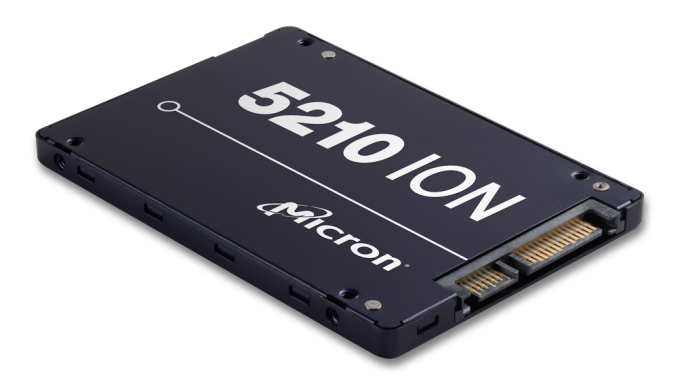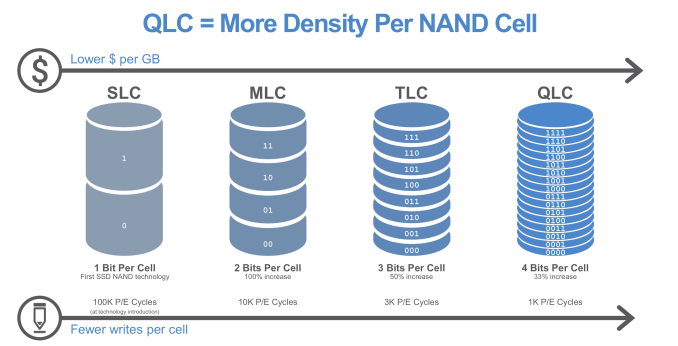Intel And Micron Launch First QLC NAND: Micron 5210 ION Enterprise SATA SSD
by Billy Tallis on May 21, 2018 4:30 PM EST
Intel and Micron are announcing today that their jointly-developed QLC NAND flash memory is now available, and Micron is now shipping the first solid state drive based on QLC NAND: an enterprise SATA drive branded the 5210 ION series. This will join the TLC-based 5200 family as a lower-cost tier with reduced write performance and endurance.
QLC NAND flash memory stores four bits of data per memory cell, providing a 33% capacity boost over three bit per cell TLC NAND, which is now used in almost all SSDs. The downsides are that QLC NAND has lower write endurance on the order of 1000 program/erase cycles, and lower write performance. Both of these are consequences of the difficulty of discriminating between 16 possible voltage levels within a memory cell, as compared to the 8 voltage levels required to store three bits per cell.
The cost reduction brought by QLC NAND is a much-awaited advance for enterprise storage. Most NAND flash manufacturers have started sampling QLC NAND within the past year, generally built on the same 64-layer 3D NAND processes that current-generation TLC NAND uses. Micron has previously shown wafers of 512Gb 64-layer QLC when announcing the addition of QLC to their roadmap, but today they are also announcing a 1Tb 64L QLC part—the first 1Tb memory chip to hit commercial availability. That 1Tb part is organized as four planes that can be processing I/O commands in parallel, compared to two planes for previous Intel/Micron NAND parts. This helps offset most of the performance loss associated with increasing per-die capacity. Thanks to the "CMOS under the array" design of Intel/Micron 3D NAND, the extra peripheral circuitry requried by doubling the number of planes doesn't add much to the overall die size.
It was initially feared that QLC write endurance would be low enough that drives would need to be treated more or less as write-once, read-many (WORM) devices, requiring careful handling on the software side. With multiple manufacturers now rating their QLC NAND for around 1k P/E cycles, it is clear that QLC-based SSDs aren't too fragile and can handle many existing workloads without needing major software changes to reduce writes.
Micron is primarily marketing the 5210 ION SSDs as replacement for hard drives, rather than replacements for any existing tier of enterprise SSD products. In this role, the 5210 ION will have clear advantages in density (with 2-8TB per 2.5" drive) and performance. QLC NAND only provides incremental improvements to cost, so the 5210 ION won't be matching 7200RPM hard drives for price per GB, but 10k RPM drives will probably be feeling the pressure, especially from TCO calculations that take into account the power efficiency advantages of SSDs.
Micron isn't providing detailed specifications for the 5210 ION series at this time, but we can read between the lines. The 5210 ION series is based on the same controller and firmware platform used for the 5200 and 5100 families. That means a Marvell 88SS1074 controller, and Micron-written firmware with features like their FlexCapacity configurable overprovisioning to trade capacity for performance and endurance.
| Write Endurance (Drive Writes Per Day) |
|||||
| Capacity | 5210 | 5200 | |||
| ION | ECO | PRO | MAX | ||
| 240 GB | 5.0 | ||||
| 480 GB | 1.0 | 5.0 | |||
| 960 GB | 1.0 | 1.3 | 5.0 | ||
| 1920 GB | <1 | 1.0 | 1.7 | 5.0 | |
| 3840 GB | <1 | 1.1 | 2.5 | ||
| 7680 GB | <1 | 0.6 | |||
Specific performance numbers haven't been disclosed, but Micron has indicated that both random and sequential read performance will be comparable to the 5200 family—meaning the 5210 can saturate the SATA link at higher queue depths. Write performance will be lower than the 5200 ECO but still higher than what a hard drive can deliver, especially for random writes.
The most important question is what the write endurance of the new QLC-based SSDs will be. The 5210 ION's endurance rating will be less than that of the 5200 ECO, which is rated for around 1 DWPD in most capacities. Micron indicates that their QLC NAND is good for around 1k Program/Erase cycles, which suggests a limit of at most about 0.5 DWPD before write amplification is taken into account. This is still higher than many consumer SSDs, where 0.3 DWPD is a typical rating for entry-level SATA SSDs with 3D TLC NAND.
When used for tasks where the performance of hard drives is currently adequate, the write endurance of the 5210 ION shouldn't be much of a problem. An endurance rating of about 0.1 DWPD would be sufficient for the 5210 ION to handle more random writes over its 5-year warranty than a hard drive can provide, but for sequential workloads it will still be possible to wear out the 5210 by writing to it at hard drive speeds. But Micron isn't recommending the 5210 ION for continuous video recording; instead they are pitching it for workloads that are at least 90% reads.
The Micron 5210 ION is now shipping to select customers with capacities from 1.92TB to 7.68TB, and will be broadly available this fall. Exact pricing and specifications will be released at that time. Intel has not yet announced any products using QLC NAND, but we expect product announcements and possibly shipments in time for Flash Memory Summit in August.
Intel and Micron are also working on their next generation 3D NAND manufacturing process, which increases the layer count to 96. This will provide a bigger density boost than a switch from TLC to QLC. It appears that development is currently focused on 96L TLC parts of unspecified capacity, but they will surely be followed by 96L QLC parts as well. Beyond 96 layers, Intel and Micron's long-standing partnership in flash memory technology will come to an end, with the two companies developing their flash independently. Neither company has shared any roadmap information going past this split, so it is not clear to what extent their designs will diverge with what will probably be the 128-layer generation.
Source: Micron











38 Comments
View All Comments
Rictorhell - Monday, May 21, 2018 - link
Hopefully they will be cheaper than similar capacity Samsung drives, which haven't decreased in cost, at all, for several years. In particular, the 2.5" form factor Samsung drives that are 2tb and higher in capacity. If the price of these drives are anywhere near reasonable I will definitely be taking a look.Samus - Tuesday, May 22, 2018 - link
Hasn't hit retail yet but when it does I'd guess close to $0.10 per GB, or $200 for 2TB, according to the IDC chart referenced in this article:https://www.theregister.co.uk/2017/05/22/ssd_price...
And following economic history of TLC over MLC, where costs fell 50% (excluding the whole spike during the NAND shortage last year) from $0.25/GB to $0.17/GB.
The whole curveball in this is QLC isn't exactly as effective as TLC was over MLC. The diminishing returns for every expansion of voltage states just wont show the impact MLC had over SLC, and TLC had over MLC, but...the real wildcard here is the 1Tb memory chips. Those at scale will greatly increase supply if yields are on par with 512Gb chips. And processing four planes in parallel +0.0+
Kristian Vättö - Tuesday, May 22, 2018 - link
Theoretically QLC is 25% cheaper to fab compared to TLC, but when considering the additional overheads (ECC area, extra peripherals etc), the reality will be closer to 15%. 1Tbit QLC die is simply larger than 512Gbit TLC die. It's an evolution rather than a revolution.Valantar - Tuesday, May 22, 2018 - link
25% cheaper to fab - by what metric? Per wafer? Per die? Per Gb? The last one is the only one that matters.Kristian Vättö - Wednesday, May 23, 2018 - link
Per Gbit. Four bits instead of three yields 33% increase in Gbit per wafer (ceteris paribus), which means 25% lower cost per bit (1/1.33-1).AbRASiON - Monday, May 21, 2018 - link
Waiting so, so, so long to replace my 5TB disks in my NAS (late 2014 Purchase date) with 8TB SSDs. I'm thinking it's still 3+ years out. >:(Samus - Tuesday, May 22, 2018 - link
Economically, yes. But you will probably be able to buy relatively inexpensive 4TB retail\commercial SSD's for ~$300 next year, and you can fit 2 of them in the space of one 5TB 2.5" disk.As Intel said TEN years ago when they launched the X25-M: we will have magnetic storage through the next decade, but it will be application specific, not general use. Application specific is becoming a pseudonym for bulk storage\cold storage. There should be no realistic reason PC's will come with hard disks in the next year or two when 1TB QLC drives are almost as cheap as 1TB hard drives.
DanNeely - Tuesday, May 22, 2018 - link
on bottom end laptops spinning rust continues to cling on because it's minimum viable price is lower than the cheapest SSDs can go (controller costs and minimum nand die counts for decent perf keep the cheapest SSD more expensive than the cheapest HDD); IMO the pursuit of thinner is better is the only thing likely to actually kill them off in the next year or two.As far as bulk storage goes, I suspect the NAS I build sometime in the next 3-12 months will be the last time I purchase spinning rust. Projections from the last few years show the mid 2020's as when flash finally becomes cheaper as bulk/cold storage. Even if that date slips to the late 2020's I suspect the gap will be narrow enough that going with a much smaller box will be worth whatever lingering price premium remains.
jjj - Tuesday, May 22, 2018 - link
Battery, thermal, volume and weight are costs and low end is actually already NAND as most 200-300$ laptops use eMMC. HDDs have controllers too, a costlier shell and can't scale to small capacities. A 16GB eMMC must be 5-6$ now.Would be interesting if PC SoCs would support uMCP https://www.micron.com/products/multichip-packages...
NAND penetration in PC is likely about 5 years away from 100% - ofc some PCs will have both SSDs and HDDs.
ಬುಲ್ವಿಂಕಲ್ ಜೆ ಮೂಸ್ - Tuesday, May 22, 2018 - link
Depends on what you mean by "Cold Storage" SamusI can unplug and put "quality" hard drives into storage today and be assured the data is still there in 100 months
These new QLC SSD's on the other hand can be unplugged for up to 3 months an still be assured your data is still there
So, until the new tech can retain data as long as old tech, I'll keep irrelevant data on the fastest SSD, massive Volumes of what I want to keep on hard disk, and critical data on M-Disk (and hard disk)